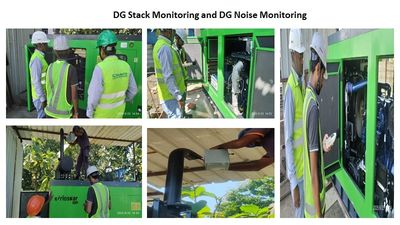Signed in as:
filler@godaddy.com
Signed in as:
filler@godaddy.com

Ambient Air Monitoring refers to the process of measuring and assessing the quality of the air in the surrounding environment (outdoor air). This monitoring is conducted to track the concentration of pollutants in the air, ensuring they remain within safe limits and do not pose health risks to humans, animals, and the environment. Ambient air monitoring plays a critical role in public health, environmental protection, and regulatory compliance. Purpose of Ambient Air Monitoring:
Indoor Air Monitoring refers to the process of measuring and assessing the quality of the air inside buildings, homes, offices, and other enclosed spaces. Indoor air quality (IAQ) is crucial because people spend a significant amount of time indoors, and poor air quality can have immediate and long-term health impacts. Monitoring indoor air helps identify harmful pollutants, assess the effectiveness of ventilation systems, and ensure the environment is safe for occupants. The Key Aspects to go for the Indoor Air testing is:
Noise Monitoring involves measuring and analyzing sound levels in a particular area to assess its impact on the environment, human health, and compliance with legal standards. It is commonly used in industries, urban areas, construction sites, and other noise-sensitive zones to manage and mitigate noise pollution.
Noise monitoring typically involves recording sound levels over time using specialized equipment and analyzing the data to ensure compliance with environmental regulations, workplace safety standards, and community guidelines. Key Aspects of Noise Monitoring
Stack Monitoring refers to the process of measuring the emissions released from industrial stacks, chimneys, or flues, which are the vents used to expel gases from combustion or industrial processes into the atmosphere. This monitoring is critical for assessing and controlling air pollution, ensuring compliance with environmental regulations, and protecting both public health and the environment from harmful emissions. Stack Monitoring can be done below parameters:
Ventilation Survey in Air Monitoring refers to the systematic process of evaluating the effectiveness of ventilation systems within a building or industrial setting. It involves measuring and assessing air quality, airflow patterns, air exchange rates, and the performance of ventilation equipment to ensure that indoor air quality (IAQ) is adequate and safe for occupants. Components of Ventilation Survey are:
An Illumination Survey is the process of measuring and assessing the quality, quantity, and distribution of light in a given space to ensure that lighting conditions meet the specific needs of the environment and comply with relevant safety and health standards. Illumination surveys are commonly conducted in workplaces, offices, industrial facilities, schools, healthcare settings, and public spaces to evaluate how well the lighting supports the intended activities while maintaining energy efficiency and safety.
DG Insertion Loss refers to the loss of power or signal strength when a diesel generator (DG) is inserted into an electrical circuit or system. The term "insertion loss" generally applies to situations where a device or component is added to a system, and it causes a reduction in the efficiency or strength of the signal or power flow. In the context of diesel generators, the insertion loss typically refers to the reduction in the electrical performance of the system after the generator is connected or engaged. Key Aspects of DG insertion loss
Electrical Power Loss
Mechanical Losses
Signal or Voltage Drop
Harmonic Distortion
Connection Losses
Factors Influencing DG Insertion Loss
Reducing DG Insertion Loss
A Vaccination Drive in the Food Industry is an organized effort to immunize employees working in the food and beverage sector against communicable diseases. A well-executed vaccination drive is a proactive step toward safeguarding public health, ensuring food safety, and strengthening the food industry’s role in preventing communicable diseases.
FOSTAC (Food Safety Training and Certification) is a training program initiated by the Food Safety and Standards Authority of India (FSSAI).
Team of FoSTAC Training Attendant.
We use cookies to analyze website traffic and optimize your website experience. By accepting our use of cookies, your data will be aggregated with all other user data.